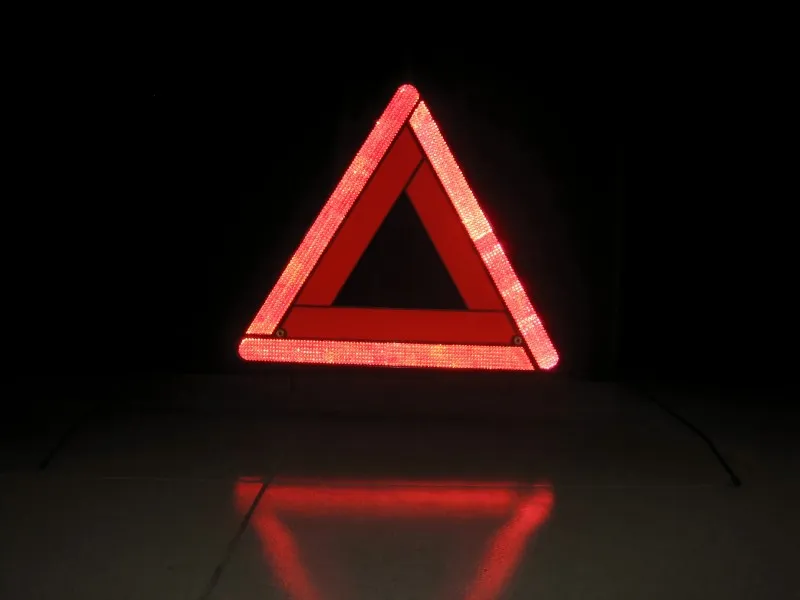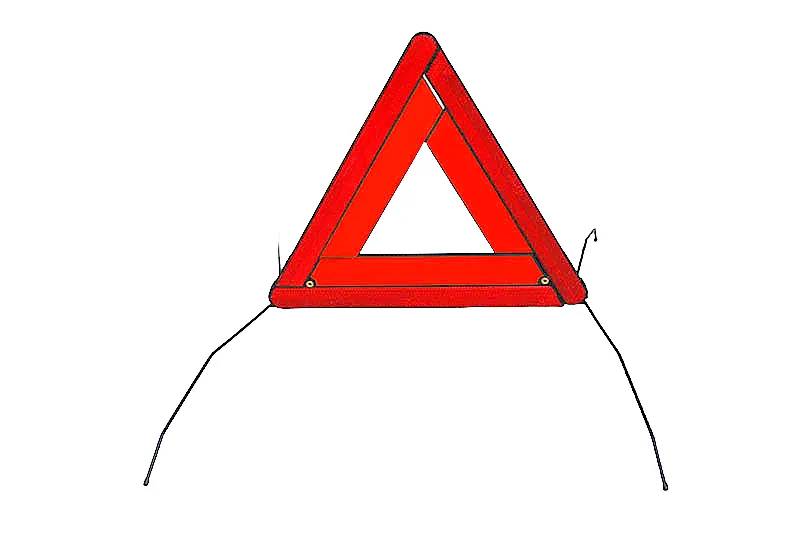Introduction
Warning triangles are essential safety devices used to alert other drivers of potential hazards on the road. They are mandatory in many countries and serve as a crucial tool in preventing accidents. This guide explores the production, maintenance, transportation, and proper usage of warning triangles to ensure optimal performance and compliance with safety regulations.
Production of Warning Triangles
Material Selection
Warning triangles are typically made from high-quality, durable materials that ensure visibility and longevity. The frame is often constructed from impact-resistant plastic or metal, while the reflective surface is composed of high-intensity prismatic sheeting. The base should be weighted to withstand wind and passing vehicle turbulence.
The choice of materials directly impacts the effectiveness of a warning triangle. High-quality plastics provide lightweight durability, while metal frames offer added strength. The reflective coating must meet strict standards to ensure maximum visibility in low-light conditions.
Manufacturing Process
- Material Preparation: Raw materials such as plastics, aluminum, or steel are sourced and cut into required shapes.
- Molding and Cutting: The frame and support structures are molded or stamped into the proper design.
- Application of Reflective Coating: High-intensity reflective film is applied to enhance visibility.
- Assembly: The components are joined together to ensure a stable, foldable structure.
- Quality Control: Each warning triangle undergoes rigorous testing for reflectivity, stability, and durability.
- Final Packaging: Once approved, the triangles are packed for distribution, ensuring they remain undamaged during transit.
Regulatory Compliance
Different regions have specific standards for warning triangles. For instance:
- Europe (ECE R27 Standard) – Requires triangles to be visible from 100 meters at night.
- United States (FMVSS 125) – Mandates impact resistance and stability tests.
- China (GB 19151-2003) – Specifies dimensions, color standards, and reflectivity levels.
Manufacturers must stay up to date with evolving safety regulations to ensure their products remain compliant and effective in different markets. The testing process typically involves exposure to extreme temperatures, vibration resistance tests, and wind tunnel simulations to verify performance in real-world conditions.
Maintenance of Warning Triangles
Regular Inspections
To ensure warning triangles remain functional, periodic inspections should be conducted:
- Check for cracks or damage on the frame.
- Ensure the reflective coating is intact and free of scratches.
- Verify the stability of the base to prevent tipping.
Cleaning and Storage
- Cleaning: Use a damp cloth with mild detergent to remove dirt and grime. Avoid using harsh chemicals that may degrade the reflective surface.
- Storage: Keep the triangle in its protective case to prevent deformation and exposure to extreme temperatures. Store it in an easily accessible location within the vehicle to ensure quick deployment in emergencies.
Replacing Damaged Triangles
If a warning triangle loses its reflectivity or structural integrity, it should be replaced immediately. Worn-out triangles may not provide adequate visibility, reducing their effectiveness in emergencies.
Transportation of Warning Triangles
Packaging and Distribution
- Bulk Packaging: Manufacturers often package warning triangles in bulk using reinforced cartons to prevent damage during shipping.
- Individual Packaging: Retail versions come in compact, durable plastic cases for easy storage.
Proper packaging plays a vital role in ensuring the product reaches consumers in good condition. Some manufacturers use vacuum-sealed packaging to prevent moisture damage, while others incorporate custom foam inserts for additional protection.
Logistics Considerations
- Handling: Fragile labels should be placed on packaging to avoid rough handling.
- Storage in Vehicles: Many countries require drivers to carry a warning triangle in their vehicles, typically stored in the trunk or under the seat. Fleet operators and commercial drivers should ensure that every vehicle in their fleet is equipped with a compliant warning triangle.
Proper Usage of Warning Triangles
When to Use a Warning Triangle
A warning triangle should be deployed in the following situations:
- Vehicle Breakdown: When a car is immobilized due to mechanical failure.
- Traffic Accidents: To alert other drivers to an accident scene.
- Road Obstructions: When a fallen object or hazard is blocking the road.
- Poor Visibility Conditions: In heavy fog, rain, or snow, a warning triangle can serve as an additional safety measure.
Correct Placement of Warning Triangles
Proper placement ensures maximum effectiveness and visibility:
- Urban Areas: Position the triangle 50 meters behind the vehicle.
- Highways: Place the triangle 100 to 150 meters behind the vehicle.
- Curves and Hills: Ensure the triangle is placed before a curve or hill to provide early warning to oncoming traffic.
- Multi-lane Roads: If stranded in a fast-moving lane, place additional warning triangles at staggered distances for better visibility.
Precautions When Using a Warning Triangle
- Always wear a reflective vest when placing the triangle to enhance visibility.
- Place the triangle on a flat, stable surface to prevent it from tipping over.
- Avoid deploying triangles in high-risk zones such as blind spots or on narrow roads.
- Be cautious when setting up warning triangles on highways; wait for a safe moment to exit your vehicle and place the device.
Innovations in Warning Triangle Technology
With advancements in road safety technology, modern warning triangles now feature additional enhancements:
- LED-Integrated Triangles: Some models come equipped with LED lights for improved visibility at night.
- Automatic Deployment Mechanisms: Innovative designs allow warning triangles to unfold automatically when removed from their case.
- Solar-Powered Reflectors: These improve nighttime visibility while reducing the need for traditional reflectors.
- Smart Warning Systems: Some warning triangles are now connected to vehicle telematics, sending alerts to nearby drivers’ navigation systems.
Conclusion
Warning triangles are indispensable safety tools that require proper production, maintenance, transportation, and usage to maximize their effectiveness. By adhering to quality standards, conducting regular inspections, and deploying them correctly, drivers can significantly reduce the risk of accidents and enhance roadside safety. Ensuring compliance with regional regulations will also help manufacturers produce reliable and standardized warning triangles for global markets. Additionally, ongoing innovations in warning triangle technology continue to improve their effectiveness, making roads safer for all motorists.





Leave a comment